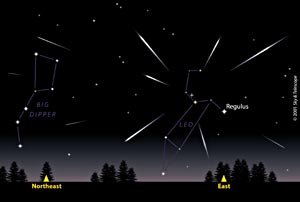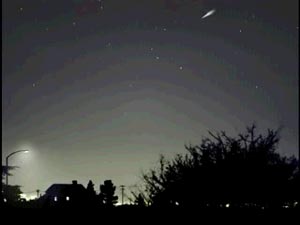Nov. 13, 2006
Contacts:
Alan MacRobert, Senior Editor
855-638-5388 x151, [email protected]
Marcy McCreary, VP Mktg. & Business Dev.
855-638-5388 x143, [email protected]
| Note to Editors/Producers: This release is accompanied by publication-quality graphics and broadcast-quality animations; see details below. |
Late this Saturday night (November 18, 2006) a meteoric sky show could break over New York, New England, and eastern Canada. According to Sky & Telescope magazine, the Leonid meteor shower — which put on intense displays from 1998 to 2002 — could return for a brief, last-gasp reprise.
Every mid-November, as Earth cruises along its annual orbit around the Sun, we pass through the Leonid meteor stream. Most parts of the stream are sparse, so we get only a very minor meteor shower (roughly 10 meteors visible per hour). But some parts of the stream are much richer. This year, reports Sky & Telescope meteor expert Joe Rao, specialists predict that we'll sail through a narrow, dense filament of the stream. The whole thing should last for only about a half hour centered on 11:45 p.m. Eastern Standard Time on Saturday night, November 18th.
In North America, only New England, easternmost New York State, and Canada's provinces from Quebec eastward will be positioned to catch the possible display. Even in these regions, the meteors will come skimming into the upper atmosphere at a low angle. This means that the numbers you'll see even during an outburst will be relatively low, perhaps one every couple of minutes. However, the meteors that you do see overhead will be long, dramatic "Earth-grazers" skimming almost horizontally. Even one of these can be a sight to remember.
Bundle up warmly, find a dark spot with an open view of the sky, lie back on the ground or in a reclining lawn chair, and just gaze up into the stars. Any Leonids you see will be coming from the northeast. Be patient.
The best place to watch from is actually westernmost Europe. Here the shower will happen just before the first light of dawn on Sunday morning; the predicted time of the shower's maximum is 4:45 a.m. GMT on November 19th. This side of the world will be facing more directly into the oncoming shower, so the meteors will fall more nearly straight down, and the observed numbers should be greater.
Background
The Leonid meteoroids are bits of debris shed by Periodic Comet Tempel-Tuttle, and they continue to travel in a broad stream along the comet's orbit. Every 33 years the comet passes through the inner solar system, warms up in the heat of the Sun, and sheds a new filament of debris, adding to the general meteor stream. When Earth encounters one of these dense new filaments (which haven't yet had time to disperse very much), we can get a very strong but short-lived meteor display.
This tends to happen around the years when the comet itself is passing through. The comet's most recent return happened in 1998, so you might expect that by 2006, all activity beyond the 10-per-hour background would be over. But experts predict maybe not.
The reason goes back several decades. On the morning of November 17, 1969 — three years after a historic Leonid storm in 1966 — an unexpected burst of Leonid activity broke over eastern North America. Some observers reported seeing an average of two to four meteors per minute. What had caught observers off guard was Earth's passage through a thin, relatively dense ribbon of dust and debris that had been shed by Comet Tempel-Tuttle in 1932. The densest part of the ribbon was less than 30,000 miles (48,000 kilometers) thick. Earth, traveling in its orbit at 18.5 miles per second, swept through it in only about a half hour.
In 1999 Robert McNaught and David Asher published a paper on Leonid dust trails in the meteor journal WGN and cited the case of the 1969 outburst. They forecast that in 2006, Earth will encounter a follow-on section of that very same dust trail from 1932. They predict that this year's encounter will be centered on 4:45 Universal Time (GMT) Sunday morning, November 19th.
Other leading meteor forecasters, such as Tom Van Flandern of the United States, Esko Lyytinen of Finland, and Jeremie Vaubaillon of France, later confirmed this encounter with the 1932 rubble trail, and their predicted times match McNaught's and Asher's to within a few minutes, Sky & Telescope reports.
So another short-lived outburst seems probable — but it's unlikely to be as intense as in 1969. That year's encounter came about 4½ years after Comet Tempel-Tuttle passed closest to the Sun. This year it's happening almost 9 years after the comet last swept through. So we'll likely pass through a sparser region of the 1932 rubble trail. A reasonable guess is that the resulting display will be about half as strong.
Sky & Telescope is pleased to make the following publication-quality graphics and broadcast-quality animations available to the news media. Permission is granted for one-time, nonexclusive use in print and broadcast media, as long as appropriate credits (as noted in the captions) are included. Web publication must include a link to SkyandTelescope.com.
 The cometary crumbs that create Leonid meteors are traveling together through space, along the orbit of Comet Tempel-Tuttle. So even though they can appear anywhere in the sky, they all seem to emanate from a spot in the constellation Leo. But in mid-November this constellation does not rise above the horizon until nearly midnight (this view is for 1 a.m. local time), so large numbers of meteors will not be seen until Leo rises. Click on the following text link to download a publication-quality version (102-kilobyte JPEG) by anonymous FTP.
|
 This is a reduced-size still frame from a simulation of a rich Leonid meteor shower as seen in a light-polluted night sky, for example, in a heavily populated area. Only a few bright meteors show through; the faint ones are hidden by skyglow. The animation illustrates how all members of the shower appear to radiate from the same direction in the sky (in the constellation Leo). Click on the following text link to download the broadcast-quality animation (107-megabyte QuickTime movie) by anonymous FTP.
|
 These are reduced-size frames from Sky & Telescope's broadcast-quality QuickTime animation showing how a meteor is formed when a speck of cometary debris burns up in Earth's upper atmosphere. Download the full animation by FTP (17 megabytes). S&T: Steven Simpson. |
About Sky Publishing
Sky Publishing Corp. was founded in 1941 by Charles A. Federer Jr. and Helen Spence Federer, the original editors of Sky & Telescope magazine. In addition to Sky & Telescope and SkyandTelescope.com, the company publishes Night Sky magazine (a bimonthly for beginners), two annuals (Beautiful Universe and SkyWatch), as well as books, star atlases, posters, prints, globes, and other fine astronomy products.
 0
0
Comments
You must be logged in to post a comment.